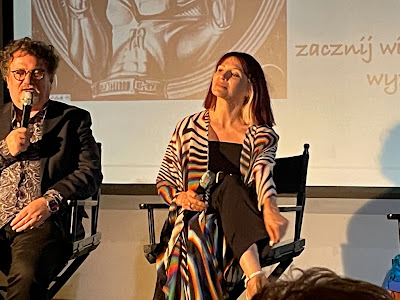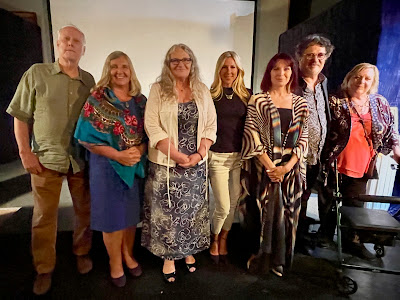Helena Modjeska Art & Culture Club presents a screening of the documentary "Struggle: The Life and Lost Art of Szukalski" with the participation of the film's producers Anna Dobrowolska and Irek Dobrowolski. Information about them is included below.
The film will be shown at LAPAC/Promenade Playhouse Los Angeles Performing Arts Conservatory - 10931 W. Pico Blvd. Los Angeles, CA 90064 – on Friday, June 21, 2024 at 7:00 p.m. Admission is free for club members, $30 for guests. Seating is limited. Checks payable to Helena Modjeska Art Culture Club or PayPal: prezes@modjeska.org. RSVP prezes@modjeska.org.
STRUGGLE: THE LIFE AND LOST ART OF SZUKALSKI (Wikipedia)
Struggle: The Life and Lost Art of Szukalski is a 2018 documentary film directed by Irek Dobrowolski, written by Stephen Cooper and Irek Dobrowolski and starring Stanisław Szukalski, Glenn Bray and Robert Williams. The documentary is produced by Leonardo DiCaprio, and his father George DiCaprio.[The film was released by Netflix on December 21, 2018. The documentary tells the story of the Polish artist Stanisław Szukalski’s troubled life and complicated body of work. He created his own language, and is an innovative sculptor, who once lost all his work in a Nazi bombing raid. It also focuses on his nationalism in the lead-up to World War II, and his subsequent transformation during the second half of his life. The documentary was reviewed positively by Karen Han in The New York Times, who stated that it "manages to deliver" on the breadth and depth implied by the title. Han noted: "Still, for Bray, George DiCaprio and others who knew Szukalski in his final years, their struggle with his past is deeply personal. They effectively become subjects themselves, grappling with how he ought to be remembered. The viewer is left to decide."
ANNA DOBROWOLSKA
Producing films and television programs since 2002, Anna's most recent release is the feature documentary Struggle: The Life and Lost Art of Szukalski from producer Leonardo DiCaprio and NETFLIX Studios. Struggle premiered on December 21, 2018 at LACMA in Los Angeles and is now available 190 countries (in 34 languages) to an audience of 160 million. Reception has been phenomenal: rave reviews in top publications from around the world (New York Times, Observer, Guardian, Daily Mirror, Tribune and many more); Netflix ranked it 4th Best Film of 2018; and ranks #5 on the list of Must See movies in 2019 according to IMDb - the most popular industry portal and the defacto authority in film and television. Her portfolio boasts an extensive run in television, having produced more than 300 episodes and 26 broadcast shows, a number of on-stage musicals with famous Polish stars played in Warsaw’s Sala Kongresowa and the Polish National Opera, and multi-award winning productions like In Fortunes Debt, Dancing with Drugs, and The Portraitist.
IREK DOBROWOLSKI
Director of over 25 documentaries and two feature films - many of which have been internationally nominated and awarded, including The Magnolia Award at Shanghai Film Festival, the Grand Prix at Stockholm’s International Film Festival, Lajkonik at Krakow Film Festival and the Golden Phoenix at Warsaw’s Jewish Motifs Festival. His film August Sky: 63 Days of Glory has become a cult favorite in Poland, with more than 350,000 Facebook fans who post poems and show off August Sky tattoo art. The trailer has garnered over 8 million views on Youtube. Irek's latest film, Struggle: The Life and Lost Art of Szukalski, was produced by Leonardo DiCaprio and released by Netflix Studios.
STANISLAW SZUKALSKI (1893-1987) AND THE MODJESKA CLUB
by Maja Trochimczyk, based on materials from Celebrating Modjeska in California: History of Helena Modjeska Art & Culture Club (Los Angeles, 2023)
Szukalski was an innovative and visionary sculptor, whose education alternated between Poland and the U.S., and who designed many original sculptures before WWII. After he refused to create a portrait of Hitler and Germany attacked Poland, his studio was targeted in bombings and all his works were destroyed by German Air Forces in the raids on Warsaw at the beginning of September 1939. He was buried in rubble during a bombing in Katowice, but survived. Several months later he was allowed to leave Poland with his American-born wife, Joan.
After the war, Szukalski settled in California and continued to design sculptures and monuments. Alas, he was only able to complete small models, portraits, paintings and medals; no large-scale sculptures were built. Two designs of Helena Modjeska Monuments are among his sketches and the Modjeska Club's founder, Leonidas Dudarew-Ossetynski was earlier the chair of a committee organized to fundraise for the construction of this monument in Los Angeles in 1955.
In an undated letter addressed to Ossetyński, kept in the Polish Museum of America’s archives with an inscription “Helena Modjeska Memorial Committee” on its back (the letter was folded and appears to have been sent on 28 September 1954, without an envelope), Szukalski wrote about his intention to portray the actress in his sculpture as a dancer that held a heart, a crown, and a moon in her hands. Posed asymmetrically like a flamenco dancer with her castanets, Szukalski’s Modjeska was towering above a knee-high model of St. Mary’s Basilica in Kraków, Modjeska’s hometown. Szukalski described this building as both “the most characteristic monument of Kraków” and “the most beautiful temple.” In this design, which could have been quite offensive to religious zealots, with the actress towering above the Basilica, in a provocative pose and scant clothing, the sculptor’s intention was for Modjeska to become “a reflection of her national origin” so that she “radiates onto the audience of foreign nations with her proud heart.”
Ultimately, the project was not realized. Instead, Szukalski designed the logo for Ossetynski's first California theatrical endeavor, that is the Modjeska Players that toured the U.S. and Canada in 1955-1958. He then designed a Copernicus poster that was distributed with signatures to Club members and an envelope to commemorate Copernicus's 500th Birthday in 1973.
The initial, highly successful event of the Modjeska Club was held in the Hollywood home of Ossetyński in May 1973. It was dedicated to the art of an original Polish sculptor, Stanisław Szukalski who hitherto stayed away from Polish émigré organizations.
Ossetyński explained:
The first event was a very important test for the Club. It was about gaining new members and drawing the attention of the Polish community to the meaning and overtones of our plans. An excellent Polish sculptor, Stanisław Szukalski, has been living in Los Angeles for years. Unfortunately, the local Polonia has not taken an interest in him, and if he is known to the newcomers, it is more for his controversial feats, not for the great works he creates in the isolation of his rich creativity. In short, I decided to familiarize my compatriots with his interesting art, and also to use it, somewhat as a lure. When I offered him a meeting where he was to give a lecture illustrated by his works, he declined. But I persisted until he agreed. I had a nose. It turned out to be a super atomic bomb. At home, the walls were bursting at the seams as it were from the excess of people who had arrived. Everyone bought an interesting lithograph of the bust of Copernicus, designed and made by the great artist, and fifteen new members signed up to the Club immediately.
Szukalski joined the group of Modjeska Club's Art Advisors and was listed on the Club's letterhead between 1973 and 1978 along with the club's co-founder composer Stefan Pasternacki, actress Stefanie Powers, fiber artist Yolanta Wojkiełło-Martusewicz, and dancer-choreographer Stefan Wenta. He designed an eagle as a logo for the Club but it was never used; instead a different design based on a Piast eagle by Waclaw Gazinski appeared on the Club's letterhead in the first decade of its existence.
At the same time, Szukalski worked on developing an all-encompassing original, and bizarre anthropological theory of “everything”—races, languages, mythologies, —that he called the “science of Zermatism.” In a 1978 note in Polish Americans in California, Gene Harubin Zygmont described him as “an esoteric artist and thinker… a writer, painter, medalist and a man of ideas” who was “very much in evidence and working in California.” In that period, he designed monuments of Copernicus; Polish officers, Prisoners of War, murdered in Katyń in Soviet Union by the NKVD; and the French Resistance fighters of WWII. None of them were built.
































